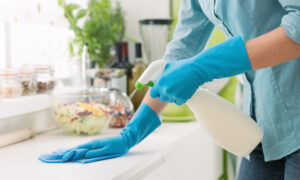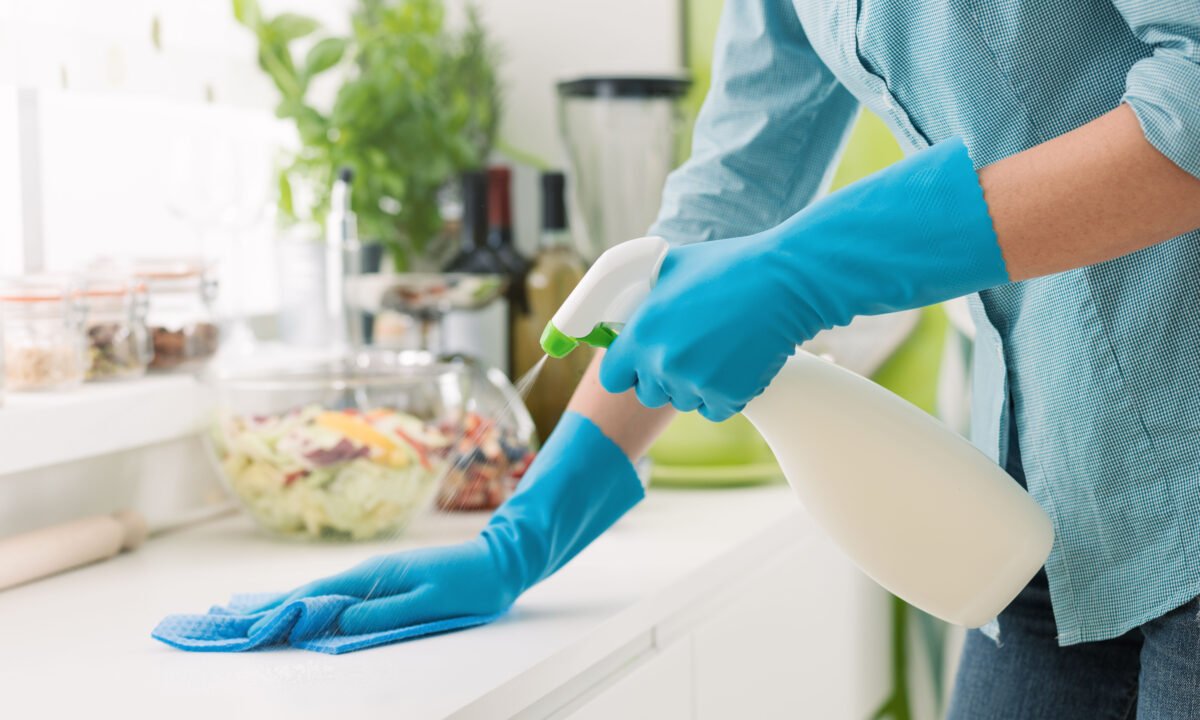Probiotic Cleaning: Health or Hype?

The disinfectants being used in homes and hospitals today might as well be completely different than grandma’s.
Something has changed, but it’s not the cleaning chemicals. Answering why might be as complex as the community of organisms that are killed off by harsh chemical disinfectants like chlorine. Yet it’s in that very community of disappearing microorganisms where scientists are discovering industrial disinfectants may be moot.
Several studies show adding more bacteria to the environment with probiotic cleaners is superior at killing germs, or pathogens, compared to chemical disinfectants. Harsher cleaning agents like bleach have to be reapplied every few hours to keep pathogens from re-emerging, as noted in a recent study comparing cleaning methods on Italian subways.
Part of the dilemma is that if someone ill is spreading more pathogens, the cleaners applied hours ago won’t do much good. A 2016 PLos One study calls it the “recontamination phenomena,” and it’s believed to be the reason pathogen transmission is problematic, especially in hospital environments where there are naturally more sick people.
But bugs can naturally kill other bugs. That’s because living among the community of bacteria, viruses, and fungi—called the microbiome—are probiotics, a word with Latin roots that means “for life.” These live bacteria offer profound health benefits that can destroy many of the disease-causing creatures lurking in this unseen world while maintaining balance in the biome.
While probiotics are becoming more familiar in the diet and supplement world, the role they play in the space around us is very similar to how they work in our bodies. They lower the risk of disease basically by overcrowding pathogens—a concept called competitive exclusion where one species steals the space and nutrients from another, thereby toppling their colonization.
A Healthy Cleaning Option
Observing this mechanism has given rise to a green cleaning option that is really a spin on an ancient approach by looking to nature and lessons in history. What is becoming apparent is that not only is it an environmentally safer alternative and better for human health, probiotic cleaners actually infuse healing properties into what scientists call our “built environment”—homes, office buildings, hospitals, and such.
In the 2016 study, conduced in a hospital setting, probiotic strains of bacillus were used in sanitation procedures to counteract the growth of pathogens. It worked, plus there were no new drug-resistant infections reported in the study. “[M]ost importantly, they decrease the population harboring drug resistance genes, which is a global concern and which is ultimately responsible for the onset of the most severe [hospital-acquired infections],” according to the study, published in PLoS One.
Despite most of the research focusing on hospitals, deadly infections can be picked up anywhere. In fact, data on particularly hard-to-treat Clostridioides difficile (c.diff) infections, deadly among the elderly and immune-compromised, shows that about half of these infections are acquired from the community and half from hospitals.
That makes probiotic use important in any indoor space, Nonia Larsen, founder of Clearwater Cultures told The Epoch Times.
“The microbiome is updating and adapting to help protect us against things. It’s doing it in live time. The microbiome adapts faster than all life forms,” she said. “I think everybody should have probiotics all through their homes.”
Larsen, who has been making her own probiotic-based products for the home since 2008, says the method allows only what is toxic and unhealthy to be naturally eliminated, rather than the killing off of all microbes—beneficial and otherwise.
“We have to change our approach that we have, going around killing everything,” she said. “We need the microbes. We need to be cleaning with them. I think this is our great hope to get back to health and sanity.”
Excessive Cleanliness May Cause Illness
Too much sanitation can be problematic, according to the authors of “Dirt is Good: The Advantage of Germs for Your Child’s Developing Immune System.”
Jack Gilbert and Rob Knight noted research linked to excessive cleanliness that includes:
- Lower rates of diseases, particularly asthma and allergies, found in households with more diverse microbes.
- Fewer cases of allergies and less asthma noted in households that wash dishes by hand versus using a dishwasher.
- Common allergies to dogs, cats, mold, dust and grass are less common in children who sucked their thumbs or bit their nails.
“While bleach products may be a good way of getting rid of molds and stains, use them sparingly,” they wrote in the 2017 book. “You do not need to bleach everything. If you are worried about dangerous food-borne illnesses spread over your kitchen counter, feel free to use an alcohol wipe or hot soapy water to clean the counter—you don’t need to bleach it.”
In fact, one study found soap and water just as effective as a single-strain probiotic cleaner in a hospital setting for preventing pathogens. “For general household cleaning, where antimicrobial resistance is not a factor, our study suggests it is best to use plain soaps, rather than disinfectants or probiotic cleaners,” according to the 2020 article in Microorganisms.
Compelling Evidence
It could be that over-sterilization habits have made our chemical-based cleaners less effective. Or maybe we just couldn’t fully understand what was happening in the micro community until years of research confirmed it. Either way, chlorine to the built environment is the equivalent to antibiotics in the gut microbiome. It’s wiping out the whole community.
And just like in the gut, our environment won’t stand a fighting chance if good bacteria are never reintroduced. Relying on bleach for pathogen control might be a bit like shoveling your driveway in the middle of a blizzard.
While it might be hard to convince the masses in a post-pandemic era to give up chemical cleaning supplies, it’s hard to argue with evidence. Here are some additional conclusions from research:
- Five Italian hospitals participated in a study replacing conventional sanitation with probiotic cleaning over a six-month period. Data was collected and compared against drug usage for patients with hospital-acquired infections. The probiotic cleaning was associated with a 99 percent decrease in antimicrobial-resistant microbes, and drug consumption associated with infections was decreased by 60 percent with associated costs down by 75 percent. Results were published in 2019 in Dove Medical Press.
- Using a probiotic cleaning solution was effective in limiting the bacterial growth of resistant bacteria in a dental clinic where infection can be acquired through aerosols, blood, saliva, and respiratory secretions. The results were reported in 2018 European Journal of Dentistry.
One observation, however, from the same 2020 study in Microorganisms study recommended using a more diverse probiotic cleaner. That study compared soap and water to the probiotic cleaner over an eight-month period using bacteria from just one phylum, bacillus. Bacillus was chosen because it’s not an infection risk and has demonstrated antimicrobial properties.
“Such a heavy predominance of one genus in a natural environment is rare…there is little natural precedent for this skewed monoculture biomimicry, and the ecological impacts of the probiotic approach are not yet understood,” the study stated. “To overcome the probiotic cleaner’s tendency to limit microbiome diversity, and to overcome antimicrobial resistance in hospitals, we suggest that diversity in probiotic cleaners should be investigated as a contributor to competitive exclusion.”
Fermented Probiotic Cleaner
- 1 cup lemon juice
- 1/2 cup raw apple cider vinegar
- 1/2 an orange
- Freshly filtered water (non-chlorinated), or well water
- 1/2 gallon mason jar
- Lock or airlock lid
- Cloth cover for the jar
- Blender or food processor
Cut the orange into small pieces, and toss it into a blender or food processor, along with the lemon juice and vinegar. Blend until the orange is finely chopped.
Pour out into the mason jar, and fill to the 6-cup mark with non-chlorinated water.
Put the airlock lid on the jar.
Let sit for two weeks. You will first smell a pleasant orange smell on the airlock, and then an alcoholic orange smell. This is normal, and how it should be.
Remove the airlock lid, and strain the liquid. Squeeze out the solids completely.
Return the liquid to the mason jar. Add more non-chlorinated water, just to return it to the 6-cup mark.
Place the Cloth Cap on the jar.
Let sit for 4-8 weeks, or until all of the alcoholic smell is gone, and the smell is more orange vinegar.
Replace the cloth cap at that point with a storage lid, and your cleaner is ready to use.
To use, dilute with a ratio of 1 part cleaner to 3 parts water for spray cleaner. Dilute at a 1:10 ratio for other cleaning tasks.
Recipe provided by FermentaCap.com




